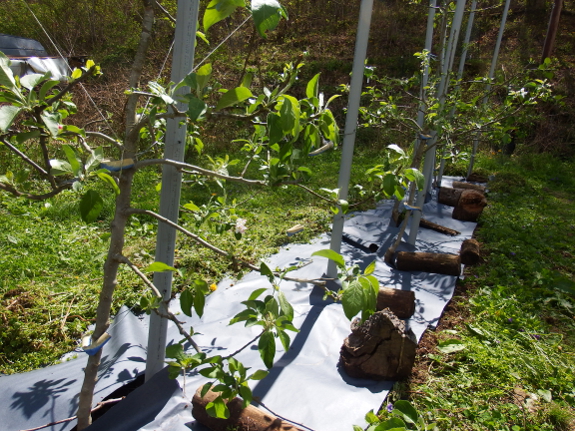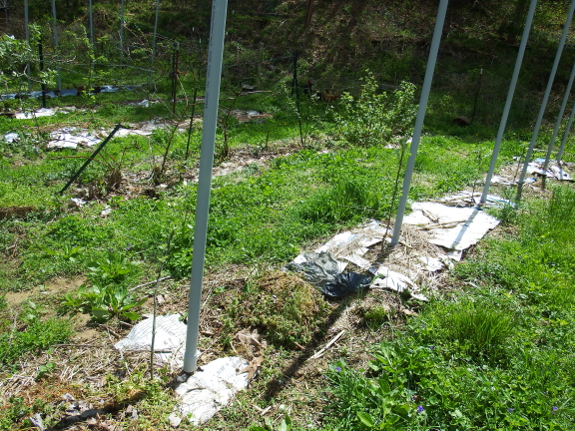
Trying out paper mulch

It feels a bit decadent to be trying out this store-bought mulch paper,
even though the price per square foot is comparable to the cost of
straw. On the up side, unlike other manufactured sheet mulches, this
paper is reputed to be fully biodegradable, so we won't have the issue
that black plastic causes, where you're picking your "mulch" out of the
soil for years to come. On the down side, the paper won't add nearly as
much organic matter to the soil as straw would, water penetration may or
may not be an issue, and I'm not sure how the paper will fare once the
areas beneath the weights begin to rot away. That's why we're only
experimenting on a small scale.
Honestly, I probably
wouldn't have even tried it, but the last year has been so absurdly wet
that I've finally ended up carrying in my mulch half a bale at a time on
my shoulder. After daily mulch walks, the garden is starting to shape
up and my stamina is much improved...but I know I won't be able to keep
up with the weed pressure of a summer garden. One roll of mulch paper
will take the place of several bales of straw and might serve as a
stopgap measure while we're waiting for either the weather to dry out or
for other people to find time in their busy schedules to work on our
driveway.

Of course, cardboard
mulch is much preferable to any kind of paper, especially amid the
perennials. The tree row above hasn't been weeded yet this year, but
it's looking pretty good regardless due to cardboard laid down last
fall. In a perfect world, I'd add mulch on top of the cardboard, but
during this stopgap year, I've instead taken to weighing down the paper
product with bits of prunings and other debris --- just enough to keep
the mulch from blowing away in our non-windy climate. Cardboard is
midway in carry-ability between the paper mulch and straw, the sticking
point there usually being sourcing the waste product.
To cut a long story
short, growing our own mulch has become much more of a priority this
year. I'm actually cutting back on nonessential parts of the vegetable
garden this year in order to have more room for cutting beds of oats, barley, sorghum-sudangrass, and pearl millet. There's nothing like a problem in the supply chain to make me want to become yet more self-sufficient in the garden!
Want more in-depth information? Browse through our books.
Or explore more posts by date or by subject.
About us: Anna Hess and Mark Hamilton spent over a decade living self-sufficiently in the mountains of Virginia before moving north to start over from scratch in the foothills of Ohio. They've experimented with permaculture, no-till gardening, trailersteading, home-based microbusinesses and much more, writing about their adventures in both blogs and books.
Want to be notified when new comments are posted on this page? Click on the RSS button after you add a comment to subscribe to the comment feed, or simply check the box beside "email replies to me" while writing your comment.
- Remove comment
- Remove comment
